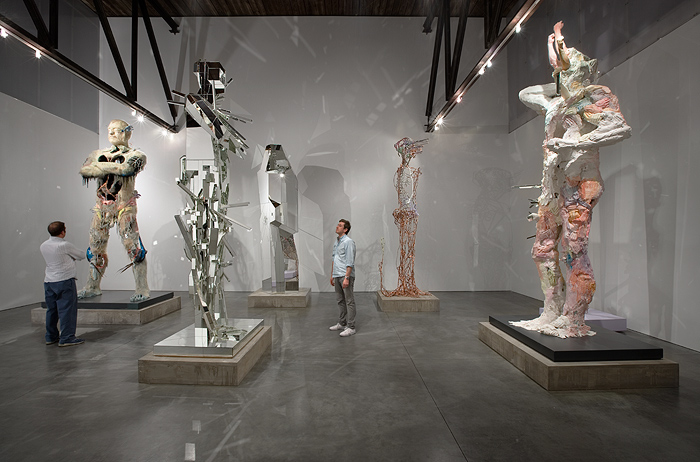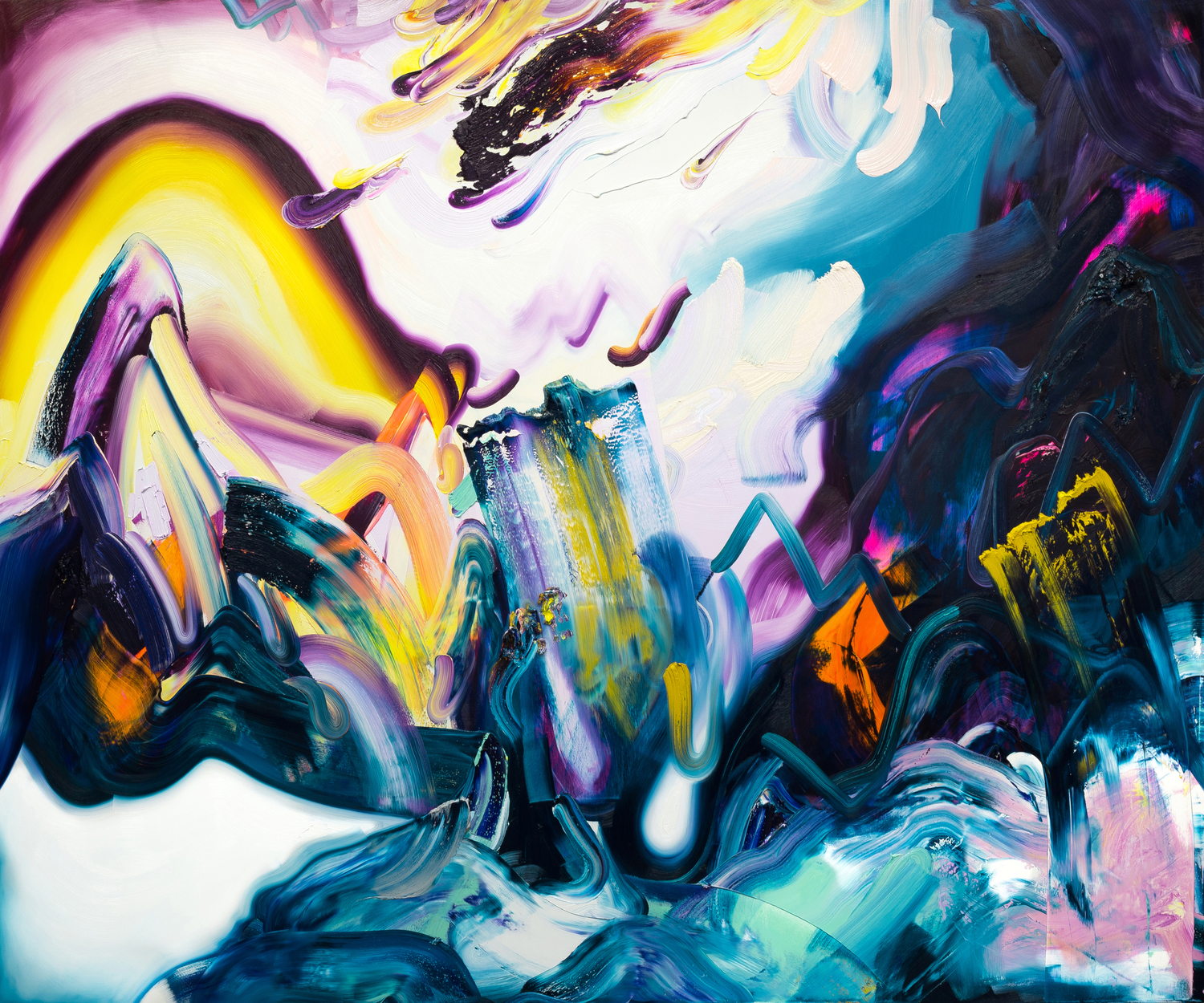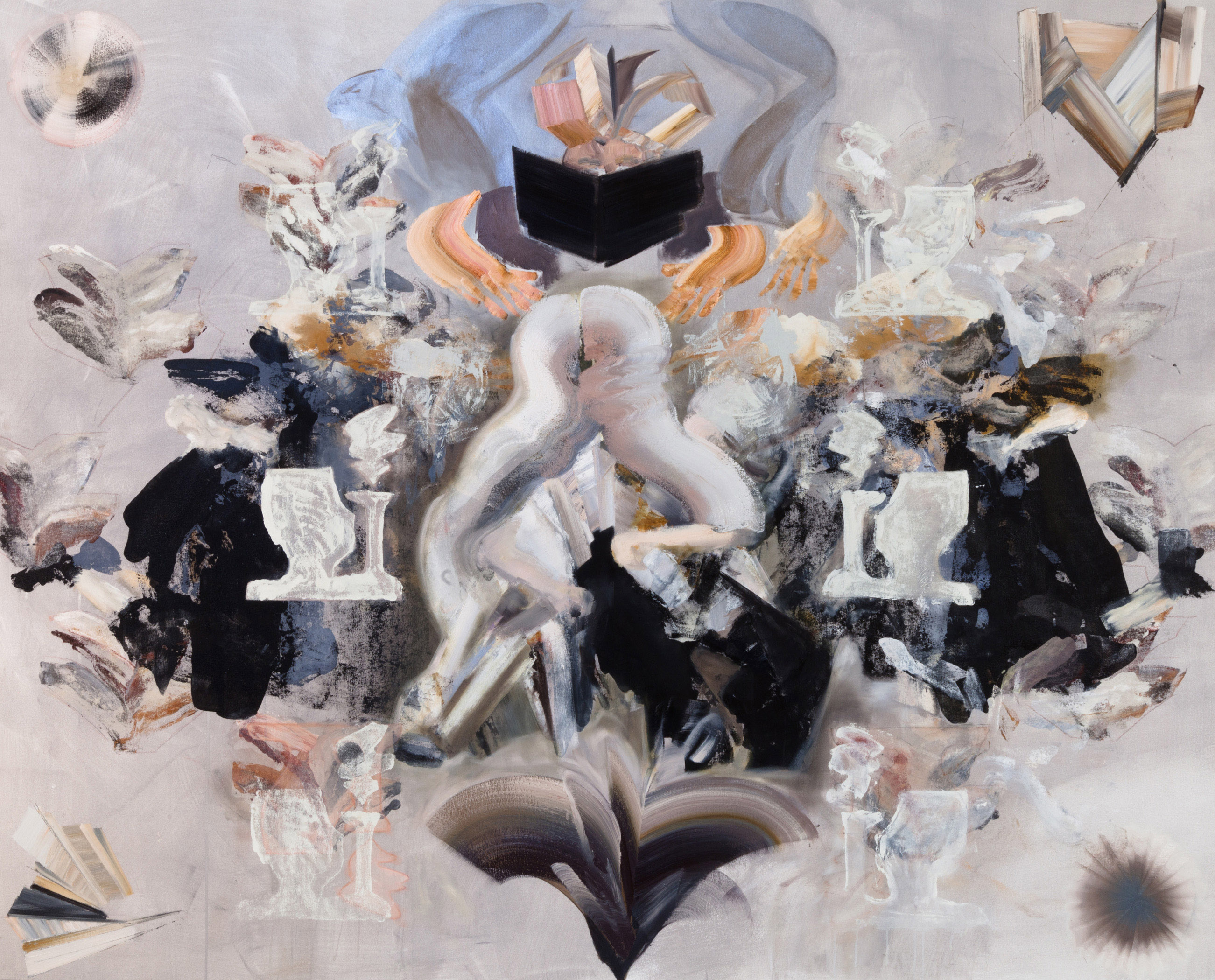By Randy Gladman. Originally published in C International Contemporary Art, Issue 84, Summer 2004
21st Century Werewolf Aesthetics: An interview with David Altmejd
Interview conducted in Istanbul, September 2003
Montreal born sculptor David Altmejd was the only Canadian artist at the 8th International Istanbul Biennial, curated by the New Museum’s Dan Cameron. Since graduating with an MFA from Columbia University in New York City in 2001, he has taken part in high profile group shows at spaces as impressive as Artists Space and Deitch Projects, received glowing reviews in The New York Times and The Village Voice, and recently signed with the Andrea Rosen Gallery. He also appears in this year’s Whitney Biennial, one of the only Canadians invited to participate in this highly influential exhibition. Yet all this attention belies the complexity of his sculptures, which purposefully intend to confound viewers. Mixing seemingly random objects such as decapitated werewolf heads with graffiti-style Stars of David, stained Calvin Klein underwear, towers made of mirrors, plastic flowers and faux jewelry, Altmejd creates sculptural systems loaded with what he calls “symbolic potential” and open ended narratives.
I caught up with Altmejd for breakfast on the roof of the Armada Hotel in the old Sultanahmet sector of Istanbul the day after the opening of the Biennial. In the shadow of the Blue Mosque with a panorama view of the Bosphorus we spoke about energy generating werewolf heads, studio visits with Matthew Barney, the relationship between art and commerce, and what it means to be a French Canadian artist working in New York City.
Randy: Your work is obtuse, difficult for people to enter. There is definite aesthetic pleasure. Anybody can look at it and see that it involves a complex system of meanings. But the connections between the elements are complicated. There are so many things that are disparate, eclectic. You use mirrors and crystals in different parts of the same sculptures that aren’t connected in any direct way. Even in a lot of the press you have earned since you began showing in New York, the writers seem to have a hard time following the connections. Are you trying to create specific meanings through the relationships of the elements, or are you leaving the meanings purposefully ambiguous?
David: I am interested in complexity as a form. I am happy when people are fascinated by the thing itself, when they are absorbed by it and know that it contains something more. Personally, I like experiencing complex objects, but not because I necessarily wish to understand the system. I am seduced by complexity itself. From my perspective, my work is intuitive. I am not able to mention specific reasons why I associate these things. I get a feeling from certain combinations, a feeling that something is going to happen when I mix things together. I do not have to say something; the object will say it. I see my installations as organisms. I start making something but at a certain point it starts making choices by itself.
R: You have particular symbols that you use like a language. They appear in different forms in different pieces and the interaction between them creates a language.
D: Rather than a language, I am more interested in how the elements create energy. I know that the things I use, the Star of David or certain words affiliated with political activism, are charged and have important meaning potential. I inject them inside the installation and the meaning potential transforms into energy. My involvement is to create something that is alive that will be able to say new things. The energy of these living abstract organisms depends on the meanings of the work being unresolved, uncontrolled. When meaning is controlled, the resulting object is not alive, there is no tension in a logical system that functions.
I am so not interested in art making as a way to communicate a specific idea. That is so boring to me. It makes the art nothing but an illustration. I want my works to have intelligence of their own, not just
be slave to my meaning. I made an installation last year at a gallery in Brussels and two guys were hanging out near the piece during the opening. When they came up to me they said, “That piece is definitely talking about the Holocaust.” In my mind I thought “No, not really”. But then I realized that just because I made the object doesn’t mean I get to determine what the object is saying. The realization that I was able to create an object that – on its own – has the capacity to talk about such a grave subject matter as the Holocaust is amazing to me. I’m not sure that I would be able to say new things about the Holocaust on my own, with a specific intention.
R: So you don’t think your work is political?
D: To me, it is all intuitive.
R: But when you use a symbol like the Star of David, it is as iconographic as a swastika. It undeniably carries a political meaning. Are you using it just to charge the work with energy? Is that responsible?
D: I know that when I use an image like a Star of David there is the potential for something to happen. A thousand things could happen. But in comparison to an icon like the swastika, the Star of David is so much more interesting. With a swastika, only one thing can happen. I know exactly how a swastika will function inside my installation. It is too obvious and I don’t like that I know what will happen. I don’t want to know. You know? I am very interested in that void. In order to make something that is new, that says new things, you have to be able to use intuition and not really know in advance what is going to happen. If it is totally controlled then there is nothing new.
R: When you use the Star of David are you thinking about the connections to what is happening in Israel? I mean, the theme of the Istanbul biennial is “Poetic Justice”. It is about justice and there is obviously a global debate going on today about justice between the Israelis and the Palestinians. I understand from what you’ve already said that you do not want to come out and explain what your work is trying to say but at the same time there is an undeniable connection between the Star of David and Israel and you are surely aware of it and aware of the fact that in Istanbul your art is showing in a Muslim country.
D: I don’t want to sound stupid or give you the impression that I do not want to take responsibility for what occurs in my work. But I feel that it is very much like having a kid. It is very problematic when your child grows up and becomes someone with a totally independent mind. What is your responsibility as a parent for the horrible things that he does as an adult? You brought that child into this world; he has half of your genetic system. You taught him to be polite, how to read, how to count. But then he has a mind of his own. I am interested in where the responsibility lies. I want to make an installation and then at a certain point step back and say “Wow, that’s amazing. It is going in all sorts of different places; it is a thing on it’s own.”
R: Werewolf heads appear again and again in your work. I’m not sure if this has a specific meaning for you or not.
D: I started using that three years ago. At the beginning it was just an alternative to the human body. I made a chopped-up werewolf. Body art is so familiar, in terms of experience. By making a monster leg, it has something of the familiar feeling but there is an added level of weirdness. Then I was very interested in the werewolf because of its complexity, its symbolic potential. It represents both good and evil, human and animal, Dr Jekyll and Mr. Hyde – extremes on both sides.
Every time I talk about my work I use the word “energy” a lot, not in a new age kind of way. The werewolf head with crystals on it is an energy-generating object. A man transforms into the werewolf, which is the most intense transformation, physically and mentally. The werewolf goes from one state, man, to a totally opposite state, animal, in the matter of minutes or even seconds. In movies it always happens in, like, thirty seconds. It even looks painful.
R: Were you thinking of pop movies like Michael J. Fox in Teen Wolf or Michael Jackson in Thriller? Do you deal with Pop issues?
D: I do deal with Pop, but that’s not where the werewolf comes from. For me, it is more of a Romantic notion from the end of the 19th century. In a story I made up about the werewolf, in the seconds right after the super-intense transformation from man into werewolf, the head is chopped off. It is put on a table, and instead of rotting the head crystallizes. The energy related to the transformation is kept inside the head and it crystallizes and becomes an energy-generating object. The architectural structure I use in the installation presents the object in such a way that triggers this energy and circulates or channels it throughout the piece.
R: There are not many artists I can think of who are doing similar work. The first time I saw it, I had a difficult time because it is so unlike what anyone else is doing. What artists have influenced you? Do you feel that you are working in a manner reminiscent of anyone else?
D: Some artists have definitely influenced me directly. Recently, however, I have got lost inside my own work. I get very absorbed. I have built enough objects and materials to use as starting points. But certainly Louise Bourgeois has taught me much about space and energy. Bourgeois has made wire fence and wood cell constructions. You cannot enter them but you can look at what is inside through openings and windows and inside there are arrangements of objects that seem like they are haunted. These works have a number of different parts but they are not installation because they are self-contained in a framework. The viewer can only walk around and peek into it and see objects that are full of memories or pain, generating a haunted-attic atmosphere.
R: Have you been influenced by Julia Kristeva’s “Powers of Horror; An Essay on Abjection”? There are a lot of seemingly abject objects in your work; death, dismemberment, scarification, corpses.
D: I am really not interested in gore. What I make has to be positive and seductive. Instead of rotting, the characters in my work are crystallizing. This makes the narratives of the pieces move towards life rather than death.
R: So even where there is a decapitated werewolf you are being optimistic?
D: Yes, totally. It is intended to be alive. Maybe weird and dark, but certainly alive.
R: You are the only Canadian in the Istanbul Biennial. Is that an honor or is that irrelevant? How does it position you?
D: Yes, I was surprised that I was the only one. I guess it is all about the way Dan Cameron decided to do his selection. I’m not sure how he proceeded.
R: Do you identify yourself as a French Canadian?
D: Depends on where I am. I don’t identify myself as a French Canadian when I am in Quebec. I did when I first moved to New York, but I don’t anymore.
R: Do you find that Americans see a difference between Canadians and French Canadians, or are only Canadians able to see this?
D: No, I don’t think they see a difference.
R: I am always interested in how Canadian artists come to be living and showing actively in New York. How did you get here and what has the experience been like?
D: Four years ago I went to grad school at Columbia University where I was lucky enough to have studio visits with great artists, practically every week. I got to see everyone from Matthew Barney to David Salle to Vanessa Beecroft – the list goes on. It was amazing, really energizing. It gave me the energy to work all night, to make sure that when Matthew Barney was on his way to my studio I would have something to show him. He is so quiet. The visit lasted 45 minutes. There is such a specific language that has been built around his work and he found a way to use his language to talk about my work. Everything he said was haunting and optimistic at the same time. He was the first person to make it clear to me that all the organic growing shapes and crystals I was using were positive. He actually used the word “hopeful”. I thought that was great.
R: In New York, your shows have received all sorts of attention. When Jerry Saltz covered “Demonclownmonkey”, an exhibition curated by the painter Matthew Ritchie, your work was prominently discussed. Then Roberta Smith gave your solo show at Ten In One a glowing review in the New York Times. Now you are in the 8th Istanbul Biennial. All of this makes me wonder how your work has been accepted back home in Montreal and Toronto?
D: Well, I have never shown in Toronto so there has been very little response to my work there. In Montreal people know me. Before I moved to New York for grad school I had some shows there.
R: But you are getting a bigger response to your work in New York than you have had in Canada?
D: Yes.
R: Do you think this is a common phenomenon?
D: I don’t think there are a lot of artists from Canada who have moved to New York. Maybe it is different from English Canada? Maybe there are more artists from Toronto who move to New York than from Montreal? I am the only French Canadian artist that I know living in New York.
R: So why did you move? Ambition?
D: I wanted to come to New York to study. And I really needed excitement for my art.
R: What do you think of the contemporary art scene in Montreal?
D: It is great. I can’t believe it is not, how do you say “diffused’ more.
R: Projected onto the world stage?
D: Yes. I am amazed. It is as if Montreal is bordered by the Great Wall of China or something.
R: Why do you think that is? I mean, from my time in New York, I’ve noticed that Americans love Montreal. They know it is a fantastic city. But yet it seems that no one goes there specifically for the art. I rarely, if ever, see art in Montreal covered in the international art press.
D: I don’t think there is encouragement to be international from people in Quebec. I mean, artists in Canada are certainly helped by government money, by grants. But I think some criticism of this situation would be healthy. I think maybe a lot of artists are hurt by this system. Once they start getting grants, it is almost like they have a job. I am not interested in that.
R: Do you think that young Canadian artists see the New York art world as inaccessible?
D: I can only talk about myself. For me, I need more than to just be part of a government granting system. I understand that the Canadian government has to support culture because there is a lack of a market for this kind of work. I also think that in Canada there is perhaps more of this idea that commerce is evil, that commerce should be avoided, that a commercial context is bad for creation because it influences artists and encourages them to make things just so they can sell them. But this is stupid. There is intelligence everywhere, in every kind of context. There is a way to make something intelligent in a commercial context just as well as there is in a non-profit context. Of course the art may look different, but that doesn’t mean that it is not going to be just as smart and valuable. I believe the market is a good force. I am not suggesting that non-profit art spaces and government sponsorship and the like are unnecessary, because they certainly are necessary. I just think that the market is great and that there needs to be a healthy combination of both things.


